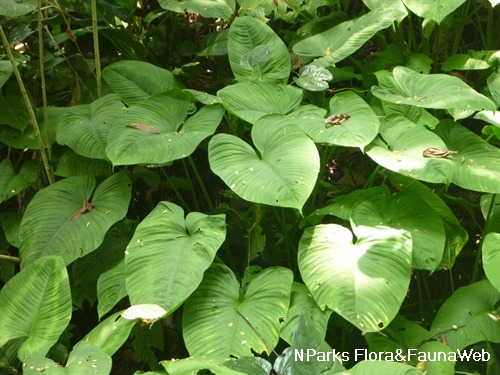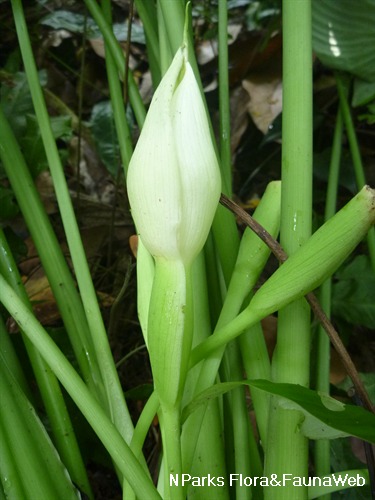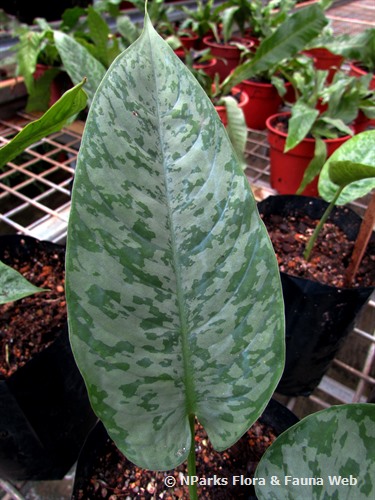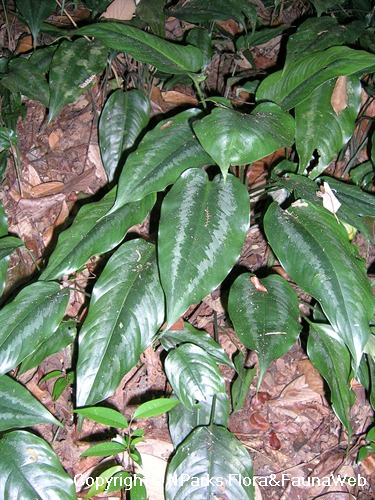
Name
Classifications and Characteristics
| Plant Division | Angiosperms (Flowering Seed Plants) (Monocotyledon) |
|---|---|
| Plant Growth Form | Herbaceous Plant |
| Lifespan (in Singapore) | Perennial |
| Mode of Nutrition | Autotrophic |
| Plant Shape | Irregular |
| Maximum Height | 0.2 m to 0.6 m |
Biogeography
| Native Distribution | Southern China, throughout Southeast Asia, to the Pacific Islands. |
|---|---|
| Native Habitat | Terrestrial (Primary Rainforest, Secondary Rainforest, Freshwater Swamp Forest) |
| Preferred Climate Zone | Tropical, Sub-Tropical / Monsoonal |
| Local Conservation Status | Non-native |
Description and Ethnobotany
| Growth Form | It is a stoloniferous, herbaceous aroid, growing up to 15 - 60 cm tall. |
|---|---|
| Foliage | The leaves are heart-shaped to arrowhead-shaped, growing up to 7 - 35 cm long and 4 - 18 cm wide, occasionally variegated with sparse light green splotches. The leaves are petiolate and arranged in a rosette. |
| Flowers | The inflorescence is a spadix, subtended by a pale green spathe. The spadix can reach up to 3.5 - 12 cm tall, with a lanceolate appendix (upper, infertile portion of the spadix), followed by reduced male flowers and reduced female flowers towards the base. The upper portion of the spathe withers and falls off during the maturation of the male flowers. |
| Fruit | The infrutescence is a cluster of berries. |
| Habitat | It grows in the understorey of dense tropical forests, often on moist soils. |
| Associated Fauna | The flowers are pollinated by insects such as beetles, and the fruits are eaten by birds and other mammals. |
| Cultivation | It can be propagated by seed or division of the stolons. |
| Etymology | The genus Schismatoglottis is derived from Ancient Greek schismatos "separating", and glotta "tongue", referring to the deciduous upper part of the spathe. The specific epithet calyptrata means "veiled" or "hooded". |
Landscaping Features
| Landscaping | It is suitable for growing in parks and gardens under shaded or semi-shaded conditions for its attractive leaves. |
|---|---|
| Desirable Plant Features | Ornamental Foliage |
| Landscape Uses | General, Parks & Gardens, Small Gardens, Flowerbed / Border, Interiorscape/ Indoor Plant |
| Thematic Landscaping | Silver Garden, Naturalistic Garden |
| Usage Hazard - Cons | Irritant - Sap, Toxic Upon Ingestion |
| Usage Hazard - Cons Remarks | Irritant Sap/ Toxic Upon Ingestion: All plant parts contain calcium oxalate raphides, which are needle-shaped crystals that can cause irritation to skin, mouth and throat. Keep plants away from children and pets. |
Fauna, Pollination and Dispersal
| Pollination Method(s) | Biotic (Fauna) (Insects (Ant, Beetle, Fly, Thrip, Wasp)) |
|---|---|
| Seed or Spore Dispersal | Biotic (Fauna) |
Plant Care and Propagation
| Light Preference | Semi-Shade, Full Shade |
|---|---|
| Water Preference | Lots of Water, Moderate Water |
| Plant Growth Rate | Moderate |
| Rootzone Tolerance | Moist Soils, Well-Drained Soils, Fertile Loamy Soils, Easy to Grow |
| Propagation Method | Seed, Division |
Foliar
| Foliage Retention | Evergreen |
|---|---|
| Mature Foliage Colour(s) | Green |
| Mature Foliage Texture(s) | Smooth |
| Foliar Type | Simple / Unifoliate |
| Foliar Arrangement Along Stem | Rosulate / Rosette |
| Foliar Attachment to Stem | Petiolate |
| Foliar Shape(s) | Non-Palm Foliage (Sagittate, Cordate) |
| Foliar Margin | Entire |
| Foliar Apex - Tip | Acute, Cuspidate |
| Foliar Base | Cordate |
Floral (Angiosperm)
| Flower & Plant Sexuality | Unisexual Flowers , Monoecious |
| Flower Colour(s) | Cream / Off-White, White |
|---|
| Flower Grouping | Cluster / Inflorescence |
| Inflorescence Type | Spathe & Spadix |
Fruit, Seed and Spore
| Mature Fruit Colour(s) | Orange |
|---|---|
| Mature Fruit Texture(s) | Glossy / Shiny |
| Fruit Classification | Simple Fruit |
| Fruit Type |
Image Repository
Others
| Master ID | 31305 |
|---|---|
| Species ID | 5702 |
| Flora Disclaimer | The information in this website has been compiled from reliable sources, such as reference works on medicinal plants. It is not a substitute for medical advice or treatment and NParks does not purport to provide any medical advice. Readers should always consult his/her physician before using or consuming a plant for medicinal purposes. |



